Financial modelling
It’s important to constantly evaluate your financial situation to handle potential risks and prepare for the future.
You must identify cash trends, spot and fix issues, and have a plan in place to analyze and predict how forthcoming events or changes will affect your financial performance.
But, how do you do this?
Financial models are the answer.
A financial model involves outlining a list of all organizational expenses and revenue and using this information to forecast financial performance and improve decision-making.
A financial model helps answer questions such as:
- What’s the net present value (NPV) of a company?
- How will a new project affect profitability?
- What are the risks and opportunities in different scenarios?
Financial modelling requires a comprehensive understanding of accounting, finance, and business metrics. It also requires you to think creatively and logically, and have a keen eye for detail to ensure nothing slips.
In this article, let’s explore financial modelling basics, its types, and the best practices you need to follow and look at some of the best solutions in the market.
Also, Read: Budgeting and Forecasting
What is financial modelling?
The process of creating a numerical representation of your company’s current financial situation is known as financial modelling. This means taking stock of current revenue, expenses, debts, and more.
A good financial model is accurate, flexible, easy to understand, and provides valuable insights into the financial health and potential of a company or project.
Financial modelling requires various skills and knowledge, such as accounting principles, financial statements, valuation methods, functions, and Excel formulas (such as VBA macros).
However, you cannot rely on spreadsheets alone to take major company decisions because they are error-prone and inconsistent.
What is financial modelling used for?
Financial models help estimate the valuation of a business or make comparisons in the industry.
Some common uses of financial modelling include:
- Valuation: It estimates a company’s value or an investment, such as stocks, bonds, or real estate.
- Forecasting: You can also use it to forecast line items such as future revenue, expenses, and cash flows.
- Budgeting: Financial modelling helps build budgets and allocate resources based on projections.
- Risk management: Financial modelling also assesses market, credit, or operational risks.
Also, Read: What is Embedded Finance?
Types of financial models
There are various types of financial models, and each produces different results depending on the inputs.
Here are five common types and real-world examples:

1. 3-statement model
This model projects a company’s income and cash flow statement, and its balance sheet.
- The income statement shows the company’s revenues, expenses, and profits over a given time
- The balance sheet includes the company’s assets, liabilities, and equity,
- The cash flow statement displays the company’s inflows and outflows
The statements are interconnected, and changes in one impact the others.
Say you’re a financial analyst and you have to project the financial performance for the next ten years. Here, you can use the three-statement model to predict the revenue, expenses, profits, assets, liabilities, and cash flows.
2. Discounted cash flow (DCF)
This type estimates the company’s value based on its future cash flows.
The discounted cash flow analysis takes the time value of money, which means forecasted cash flows are discounted to their current value. The model needs you to make assumptions about a company’s future cash flows, growth, and discount rate.
For example, say you’re considering investing in a startup and you’d like to estimate its value. A DCF model helps estimate the company’s future revenue and discount them back to their present value, taking the time value of money into the account.
3. M&A
This next type evaluates the financial results of mergers and acquisitions. Also known as the merger model, it considers cash flows and valuations of both the acquiring and target companies. It helps investors and analysts determine whether an M&A makes financial sense.
Imagine you work for a private equity firm considering acquiring another company. An M&A model helps evaluate the financial implications of the acquisition and considers the cash flows and valuations of both the acquiring and target companies.
4. Initial public offering (IPO)
In this model, the fair value of a company’s shares is estimated when it goes public. It considers the company’s financials, growth prospects, and market conditions. It helps investors and underwriters determine the offering price of the shares.
Suppose you’re an investment banker. You need to advise a company on its IPO. The IPO model helps estimate the fair value of the company’s shares and considers the financials, growth prospects, and market conditions.
5. Option pricing model
The option pricing model determines the fair value of options, which gives the holder the right to buy or sell an asset. It considers the asset’s price, volatility, depreciation, and interest rates. This model is used by traders and investors to determine fair value and make trading decisions.
Suppose you are a trader and you want to evaluate the call option value of a stock. In this case, you can apply the option pricing model to predict the equitable value. The option pricing model takes the stock’s underlying price, volatility, time left to expire, and interest rates into account.
Suggested Read: 10 Common Types of Financial Frauds, Example and Prevention
Benefits of financial modelling
From better decision-making to meeting compliance, here are some of the benefits of financial modelling:
1. Improved and in-depth understanding:
It requires a comprehensive understanding of the business model, business units, operations, cash flow, expenses, and revenue streams. This helps analysts understand how a business operates and the different factors that impact it.
2. Informed decision-making:
Another benefit is that it allows individuals and businesses to make better financial decisions. Financial models provide data analysis of a company’s financial situation. This helps evaluate different scenarios, such as strategy changes, market conditions, or regulations.
3. Accurate budgeting and forecasting:
You can also estimate the expected cash inflows and outflows and decide the optimal source and level of funding you require. Financial models also help create realistic budgets and forecasts.
4. Better compliance:
Financial models ensure that a company’s financial statements are as per the relevant accounting standards and regulations.
5. Business valuation:
Financial modelling helps determine the value of a business or a project by estimating future cash flows. This is useful for companies that want to sell their stake, raise capital, or merge with other organizations.
6. Risk minimization:
You can assess the potential risks and uncertainties your business could face and devise strategies to curb them.
7. Quick outputs:
With financial models, you can produce outputs quickly by using formulas and functions for automated calculations. This lets you make decisions quickly and reduces the time to evaluate different scenarios.
8. Business growth:
You can identify new opportunities for growth and expansion by analyzing market trends, demand, and competitor behavior. Financial models also help optimize resource allocation and cost of capital across different projects and segments.
Let’s now look at the four components of financial modelling.
Quick Read: 11 Best Online Business Payment Solutions
4 components of financial modelling
As you already know, financial models use various assumptions and formulas to link components and project the future performance of a company based on different scenarios.
There are four critical components you need to ensure are in place before building a financial model. These components are interrelated and must be consistent with each other.
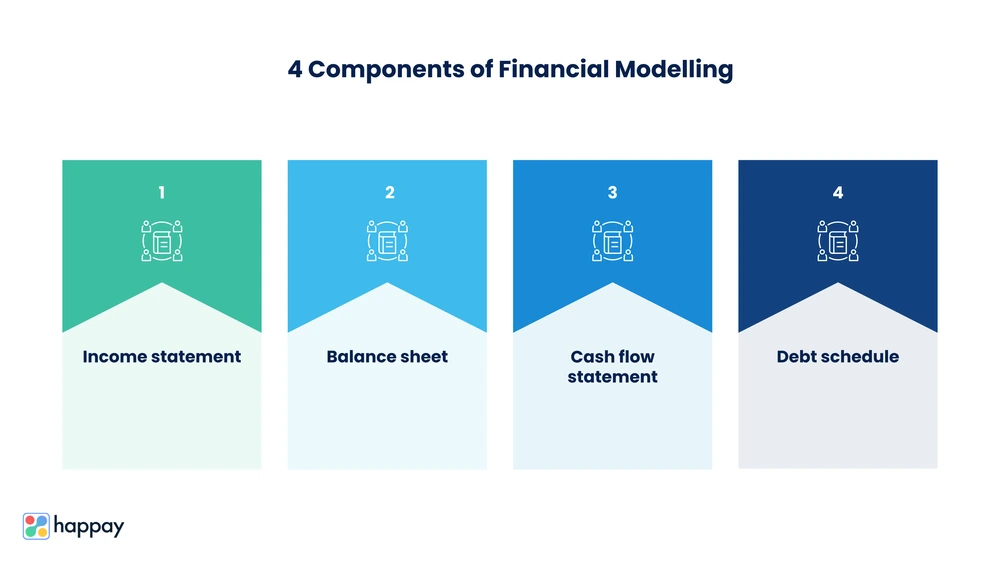
Let’s take a look at each:
1. Income statement
The income statement summarizes the revenues, expenses, and profits of a company over some time, a quarter, or a year. It shows how they generate income from operations and other sources, and how they get costs to run their business.
The bottom line of the income statement is the net income or earnings of the company.
2. Balance sheet
This statement displays the assets, liabilities, and equity of a company, usually at the end of a quarter or a year. It shows what the company owns and owes, and how much it is worth.
The balance sheet needs to follow this equation: Assets = Liabilities + Equity.
3. Cash flow statement
A cash flow statement shows the inflows and outflows of money for a company. It shows how the company generates and uses the money from operating, investing, and financing activities.
The net change in cash on the cash flow statement should be equal to the change in cash on the balance sheet.
4. Debt schedule
The debt schedule shows the amount of debt that a company has, such as loans, bonds, or leases. With a debt schedule, you can learn how much interest and principal payments the company has to make on its debt, and how it affects its cash flow and leverage ratio analysis.
Recommended Read: What is Banking as a Service (Baas)?
What is the process of financial modelling?
The financial modelling process has several steps, which vary depending on the type of model you want to develop and its purpose.
Here are some of the steps:
- The problem: The first step is to define the problem you have. For this, you need to determine the model’s objective, the data needed, and the assumptions.
- Gather data: Once you’re done identifying the problem, you need to gather data on the variables you will use in the model. For example, you could collect financial statements, market data, or economic indicators.
- Identify key drivers: Next, you have to identify the key drivers that will affect the financial outcomes of the model. These variables include sales growth rates, the total number of products or services sold, along with interest and tax rates.
- Develop assumptions: Based on your data and drivers, develop assumptions for the model. These include revenue growth projections and other variables.
- Build the model: In the next step, you have to create the model using various tools. You can use spreadsheets, financial modelling software, or program it yourself with Python.
- Test the model: Once you create the model, you must test and validate it. Run various scenarios through the model and compare the results to actual outcomes to ensure model accuracy.
Let’s now go through who’s responsible for building financial models.
Also, Read: Business Automation for Finance
Who builds financial models?
Depending on the end goal and their particular skill set, various professionals within an organization can develop a financial model.
Some examples include:
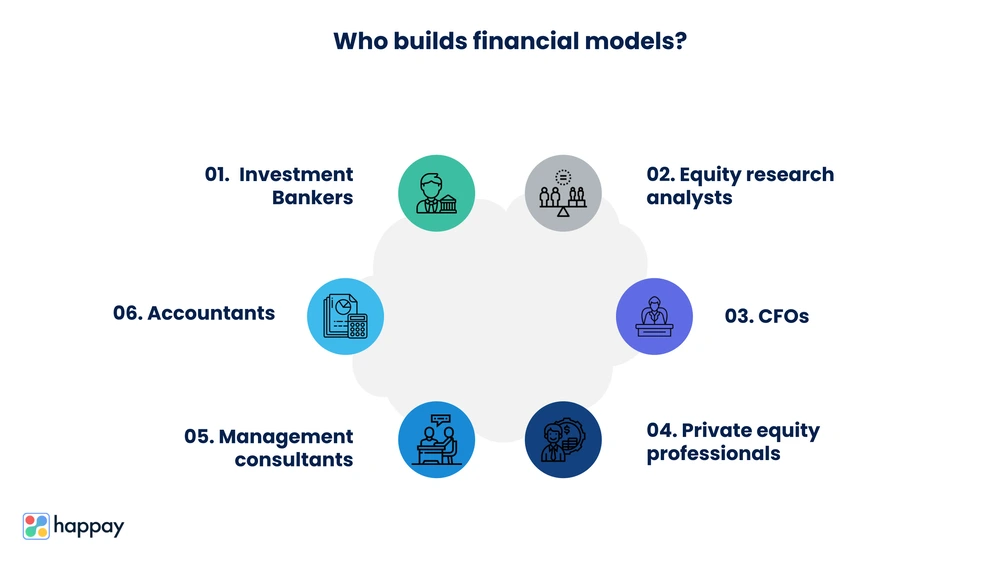
1. Investment bankers:
Investment bankers build financial models to analyze and evaluate the profitability and risks of M&As, IPOs, and other corporate transactions.
2. Equity research analysts:
These analysts evaluate the financial performance and prospects of companies and make investment recommendations.
3. CFOs:
Corporate finance professionals, such as CFOs, analyze and forecast financial performance, develop budgets and strategic plans, and assess investment opportunities.
4. Private equity professionals:
With a financial model, equity professionals evaluate and value investment opportunities and also analyze the returns and risks of investments.
5. Management consultants:
These consultants build financial models from the ground up to analyze and evaluate the impact of strategic decisions, such as entering new markets or launching new products.
6. Accountants:
Accountants build financial models to analyze financial data, prepare financial statements and reports, and provide financial advice to clients.
Also, Read: 9 Best Accounting Software in India
Financial modelling best practices
A financial model is only as good as the data and logic that support it.
Here are the best practices you need to follow while building one:
- The purpose: Clearly define the purpose and scope of the financial model. Identify the key stakeholders, data sources, and assumptions you’re going to make. You need to ensure that the model focuses on the user’s needs.
- Standardized templates: Standardized templates help ensure formatting, consistency, and accuracy. You can customize the templates to fit specific needs, but they should follow default practices and include all components.
- Data validation: Validate the data by checking for completeness, accuracy, and consistency. This involves reconciling data sources, identifying errors, and ensuring the data is updated.
- Assumptions: Test all the assumptions to ensure they are reasonable and consistent with trends and historical data. You can also use sensitivity analysis to test the impact of changes in the model’s output.
- Formulas: The formulas you use should be clear and transparent, with an audit trail. This helps you follow the model easily and identify and fix errors quickly.
- Documentation: Comprehensive documentation is important to ensure the model is transparent and reproducible. This means documenting the data sources, assumptions, formulas, and outputs, as well as any changes.
- Validation: Compare the output to your actual results. Do they match? If not, identify the errors or biases and fix them to ensure data accuracy and reliability.
Suggested Read: 6 Best Cash Flow Management Software
Financial modelling software
Financial modelling software creates financial models and performs complex analyses. It lets users build, manipulate, and analyze financial data and projections.
Financial modelling software allows you to automate the process of building financial models and reduces the chances of errors that could arise from manual computations. The software includes a range of pre-built templates and formulas that serve as a starting point, as well as data visualization, scenario analysis, and sensitivity testing tools.
A popular example of financial modelling software is Microsoft Excel, which is widely used in the industry and offers a range of financial functions.
Top 5 financial modelling software
Apart from Microsoft Excel, which is widely used, other solutions help with financial modelling.
Here are some of the best financial modelling software.
1. Cube
Cube is a real-time FP&A platform that incorporates your spreadsheet and offers FP&A teams real-time access to financial and operational data, allowing for faster and better financial reporting, planning, and analysis.
Cube helps users save time, reduce errors, and improve insights, allowing them to communicate the story behind the numbers quickly. Cube bridges the best of both worlds by melding your trusted spreadsheet’s user-friendly flexibility and familiarity with the robust control and scalability of performance software.
Also, Read: 10 Best Expense Management Software
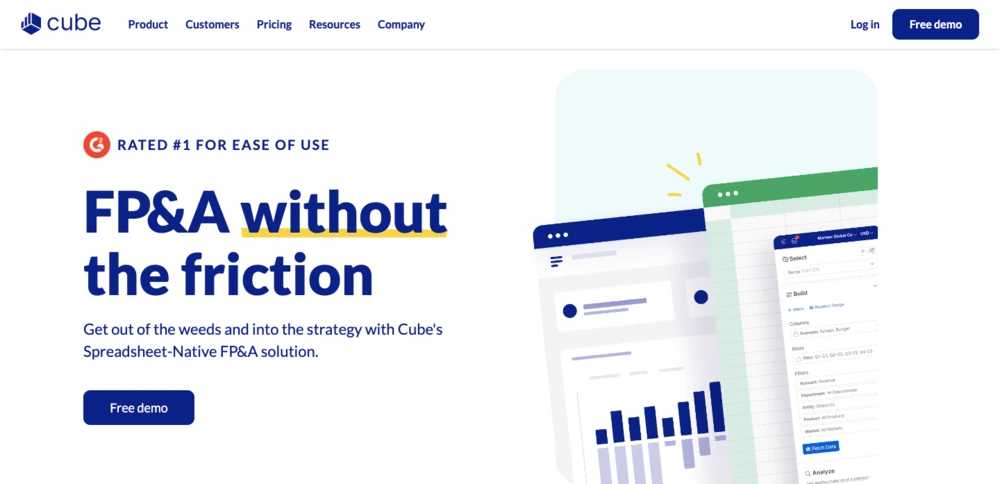
2. Anaplan
Anaplan helps optimize business planning and performance management across various functions, including finance, sales, supply chain, workforce, and marketing. The platform’s planning tools facilitate budgeting, forecasting, modelling, pricing optimization, analysis, and other planning and management tasks.
Businesses use the planning platform’s connected planning feature for modelling and planning, among other tasks. Anaplan’s calculation engine empowers thousands of concurrent users to access centralized data pools and collaborate in planning and creating models across all departments.
Quick Read: 11 Best Billing Software in India

3. Board
Board is an intelligent planning platform that helps you gain smarter planning, actionable insights, and better outcomes.
It empowers leading enterprises to uncover critical insights that inform business decisions and integrate strategy, finance, and operations to plan more intelligently and attain full control of performance throughout the entire organization.
With Board, companies can manage and regulate their entire planning process, from goal setting to operational execution.
Also, Read: Top 6 Enterprise Payment Software

4. AchieveIt
Manual processes and disconnected systems limit visibility, impact accountability, and allow day-to-day tasks to take over, leading to key plans failing. Strategy leaders rely on AchieveIt to connect, monitor, and execute their most critical plans and initiatives, enhancing visibility, increasing accountability, and promoting collaboration.
AchieveIt is trusted by global organizations for managing key plans and initiatives. AchieveIt is a strategic planning software that identifies and corrects untapped potential in your planning and execution process.
Also, Read: 9 Best Vendor Payment Management Software
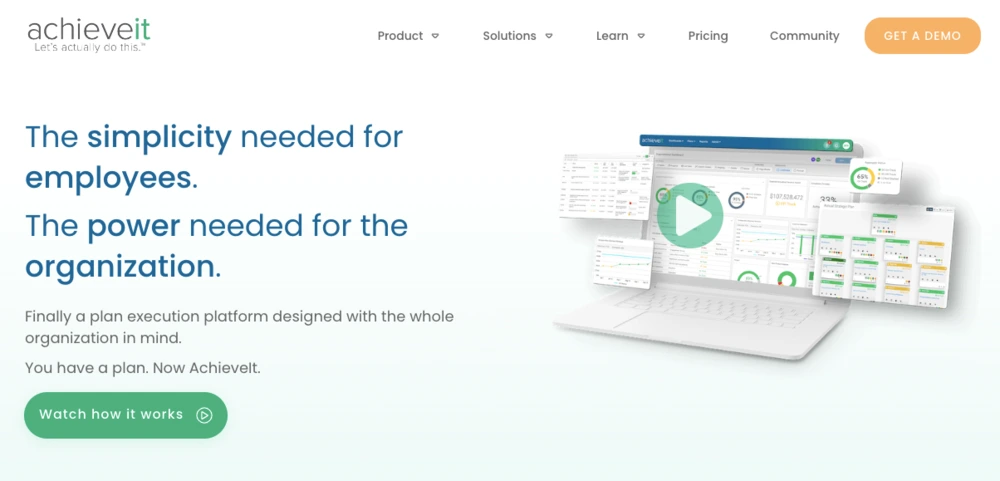
5. SAP Analytics Cloud
The SAP Analytics Cloud solution allows you to integrate analytics and planning seamlessly by integrating with SAP applications and easy access to data sources.
As the analytics and planning solution within the SAP Business Technology Platform, SAP Analytics Cloud provides trusted insights and integrated planning processes across the entire enterprise to help you make better decisions.
Also, Read: 5 Best SAP Concur Competitors
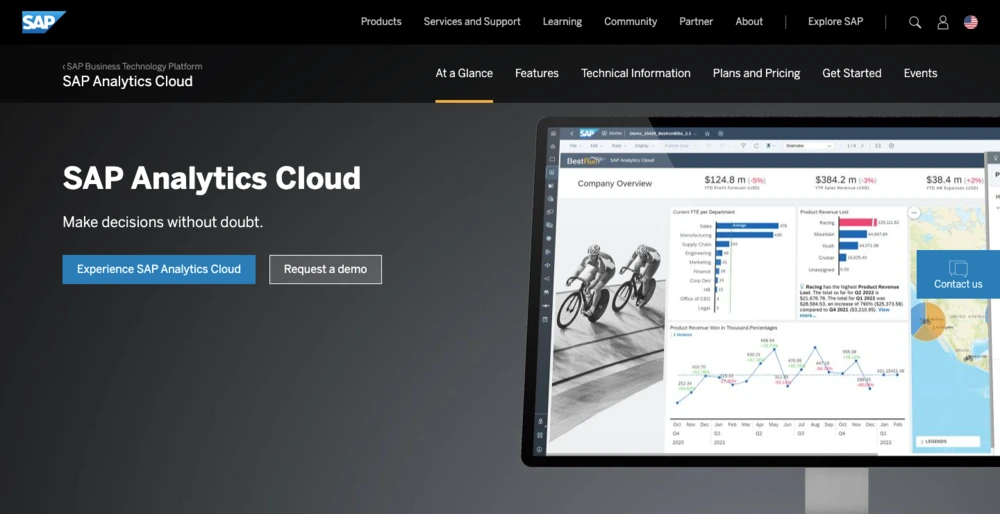
Conclusion
Financial modelling is a powerful tool for companies.
It lets you make informed investment, risk management, and business planning decisions. With accurate and robust financial models, investors and stakeholders can understand the outcomes of various scenarios and be more decisive to maximize returns and minimize risks.
However, some of the prerequisites are expertise and attention to detail to ensure that the models are accurate and reliable.
FAQs
Various professionals use it to analyze financial data and make informed decisions, such as investment bankers, equity research analysts, corporate finance professionals, portfolio managers, risk managers, accounting professionals, and consultants.
Financial modelling involves forecasting future performance based on historical data, analyzing trends, and making assumptions about future events using spreadsheets and other related software.
The financial modelling process includes identifying the purpose, selecting appropriate data sources and formulas, building a logical structure, and testing and refining it.
Excel offers a broad range of shortcuts and formulas that financial modelers utilize to perform cash flow analysis (CFA), financial statements, valuation, and other financial metrics. They favor it because it is widely available, easy to use, and handles large amounts of data. Excel workbooks also provide a flexible and customizable platform for financial modelling, letting users construct models that cater to specific needs and requirements.
To start financial modelling, learn accounting and finance basics, choose a relevant model, gather data, build and validate the model, and regularly update it. By following these steps, you gain the necessary knowledge, skills, and practice to become proficient and effectively use it as a valuable tool for decision-making and analysis.



Discussion about this post